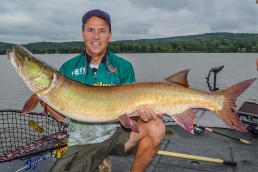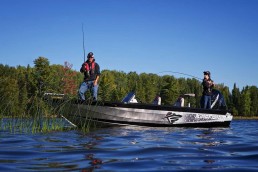Resurgence to Cover
SHARE THIS POST
September is a transition month for much of the Midwest. Water temperatures are on the decline, the trees are beginning to turn color, the days are shorter and of course the days are generally cooler. All of these factors combine to change the underwater environment. These signals also put muskies in a transition. Commonly you’ll find more muskies moving from open water toward cover. This is why you’ll find more muskies on weed edges in early September. As the month progresses and if temperatures continue to cool, you’ll also see more muskies using the flats and holding tight to weed cover.
A similar movement occurs in waters with timber. You’ll notice more muskies moving toward timber edges in reservoirs with large shad populations. As the water cools, you’ll actually get schools of shad moving to the backs of the cover. Waters with lots of rocks will see more muskies holding on top of rock humps.
The point of this is to understand that this transition month can result in muskies being on the move during September. One weekend you could be catching muskies along the weed edge, and the next weekend the bulk of the fish may be tucked into the weeds on the flat more than a cast length from the edge. Fishing memories can result in many fishless hours or days. The thought to keep in mind is that the muskies may be moving, but not necessarily too far. Overall, it’s just a movement toward the shallow cover. Also, there are some waters where the muskies will use the inside edge in September. It’s just amazing how shallow the fish can get.
On most days, I’ll start on the outside edge and if I don’t make contact with any muskies within a few hours, I’ll move shallower onto the flats. It’s important not to waste too much time on the shorter days fishing one specific area. Leave yourself enough time to fish several weed flats, or even a few inside edge areas, if the outside edge is dead.
Are you enjoying this post?
You can be among the first to get the latest info on where to go, what to use and how to use it!
In order to stay on top of the muskies, you must have an arsenal designed to fish the edges as well as the flats. I’ll usually have more lures in my boat at this time of year than any other. When focusing on the edge, Depthraiders, Bulldawgs get the nod. When fishing the shallow flats, Phantom gliders and Cowgirls become a better tool. Of course, don’t forget to fish Topraiders. September is some of the best topwater fishing across the entire muskie range. When the water temperatures are between 65 and 58 degrees, you can count on an excellent topwater bite.
Along those same lines for productive lures, the one thought that comes to mind is to slow down the lure speed. Sure there are days when burning a Cowgirl is productive, but in many situations slowing down to a medium speed is most productive. Depending upon local weather conditions, for instance if a cold front rolls through, I’ll use lots of extended pauses with my Phantoms and Bulldawgs. On the contrary if there is a warming spell and the fish seem to be following, I’ll crank up the retrieve speed slightly to try and trigger a strike.
September can be extremely frustrating, as it’s frequent fall fronts pass through that have huge impacts on the fishing. However, often it’s just a simple matter of getting into the shallow cover, slowing down and rooting out the fish. It’s sounds easy, and it can be. Yet muskies are never predictable. That’s why you always have to keep an open mind and be willing to switch locations as well as lures. Use your memories from your last trip as a starting point, but remember September is a transition month, and that the muskies may have moved shallower. Just make sure you move with them.
MWO
SHARE THIS POST
Did you enjoy this post?
You can be among the first to get the latest info on where to go, what to use and how to use it!
Jim Saric
Jim Saric is a Legendary Angler in the Freshwater Fishing Hall of Fame, the host and executive producer of The Musky Hunter television series, editor at large of Musky Hunter magazine, a seven-time muskie tournament winner, and a contributing writer for numerous other publications.



